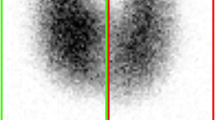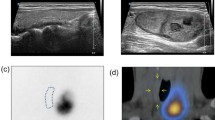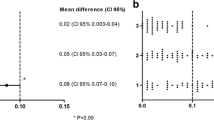Abstract
Background
123I-MIBG has been widely used in patients with heart failure and neurological disorders. The patients are pre-treated with Lugol’s oral solution or potassium perchlorate to prevent thyroid uptake of unlabeled 123I to limit the thyroid radiation exposure. However, despite the inhibition of the iodide pump, the thyroid is frequently visualized. The aim of this study was to study the pattern of thyroid uptake.
Methods
We reviewed the 123I-MIBG images of 57 patients studied in three different centers in Italy for cardiac (n = 42) or neurological (n = 15) indications. They were imaged at 15 minutes and 4 hours after injection and in all patients, the thyroid was included in the imaging field of view. In 2 of the 3 centers, the patients were pre-treated with Lugol’s oral solution and/or potassium perchlorate (group 1) but in the third center, they were not (group 2). The following imaging parameters were evaluated: heart-to-mediastinum ratio (H/M), thyroid-to-mediastinum ratio (T/M) at 4 hours, and tracer wash out from the heart (HWO) and from the thyroid (TWO).
Results
In the cardiac patients, the HWO was 22.98 ± 7.16% and TWO was 11.4 ± 11.86% (P < .0001). The TWO was 12.2 ± 13.1% in group 1 and 10.05 ± 8.97% in group 2 (P = NS). In the neurological patients the HWO was 26 ± 8.1% and the TWO was 20.32 ± 6.41 (P < .05). The difference in TWO was statistically significant (P < .01) between cardiac and neurological patients, whereas the HWO was not. The 4-hour H/M was 1.49 ± 0.23 in cardiac patients vs 1.4 ± 0.39 in neurological patients (P = NS). The 4-hour T/M was 1.33 ± 0.3 in cardiac patients vs 1.15 ± 0.13 in neurological patients (P < 0.05).
Conclusion
The thyroid visualization in MIBG imaging is likely an expression of thyroid sympathetic innervation. The differences in TWO and T/M ratio in cardiac and neurological patients probably express differences in thyroid dopaminergic receptors. Thus, pre-treatment with potassium perchlorate or Lugol’s solution may not be justified in patients undergoing 123I-MIBG imaging in whom the risk of side effects due to pre-treatment could be higher than the risk due to thyroid radiation exposure.



Similar content being viewed by others
References
Jacobson AF, Senior R, Cerqueira MD, Wong ND, Thomas GS, Lopez VA, et al. Myocardial iodine-123 meta-iodobenzylguanidine imaging and cardiac events in heart failure. Results of the prospective ADMIRE-HF (AdreView Myocardial Imaging for Risk Evaluation in Heart Failure) study. J Am Coll Cardiol 2010;55:2212-21.
Chirumamilla A, Travin MI. Cardiac applications of 123I-mIBG imaging. Semin Nucl Med 2011;41:374-87.
Kasama S, Toyama T, Hatori T, Sumino H, Kumakura H, Takayama Y, et al. Evaluation of cardiac sympathetic nerve activity and left ventricular remodelling in patients with dilated cardiomyopathy on the treatment containing carvedilol. Eur Heart J 2007;28:989-95.
Toyama T, Aihara Y, Iwasaki T, Hasegawa A, Suzuki T, Nagai R, et al. Cardiac sympathetic activity estimated by 123I-MIBG myocardial imaging in patients with dilated cardiomyopathy after beta-blocker or angiotensin-converting enzyme inhibitor therapy. J Nucl Med 1999;40:217-23.
Kasama S, Toyama T, Iwasaki T, Sumino H, Kumakura H, Minami K, et al. Evaluation of cardiac sympathetic nerve activity and aldosterone suppression in patients with acute decompensated heart failure on treatment containing intravenous atrial natriuretic peptide. Eur J Nucl Med Mol Imaging 2014;41:1683-91.
Nagahara D, Nakata T, Hashimoto A, Wakabayashi T, Kyuma M, Noda R, et al. Predicting the need for an implantable car- dioverter defibrillator using cardiac metaiodobenzylguanidine activity together with plasma natriuretic peptide concentration or left ventricular function. J Nucl Med 2008;49:225-33.
Nishisato K, Hashimoto A, Nakata T, Doi T, Yamamoto H, Nagahara D, et al. Impaired cardiac sympathetic innervation and myocardial perfusion are related to lethal arrhythmia: Quantification of cardiac tracers in patients with ICDs. J Nucl Med 2010;51:1241-9.
Arora R, Ferrick KJ, Nakata T, Kaplan RC, Rozengarten M, Latif F, et al. I-123 MIBG imaging and heart rate variability analysis to predict the need for an implantable cardioverter defibrillator. J Nucl Cardiol 2003;10:121-31.
Nishioka SA, Martinelli Filho M, Brandão SC, Giorgi MC, Vieira ML, Costa R, et al. Cardiac sympathetic activity pre and postresynchronization therapy evaluated by 123I-MIBG myocardial scintigraphy. J Nucl Cardiol 2007;14:852-9.
Sakakibara R, Tateno F, Kishi M, Tsuyusaki Y, Terada H, Inaoka T. MIBG myocardial scintigraphy in pre-motor Parkinson’s disease: A review. Parkinsonism Relat Disord 2014;20:267-73.
Navarro-Otano J, Gaig C, Muxi A, Lomeña F, Compta Y, Buongiorno MT, et al. 123I-MIBG cardiac uptake, smell identification and 123I-FP-CIT SPECT in the differential diagnosis between vascular parkinsonism and Parkinson’s disease. Parkinsonism Relat Disord 2014;20:192-7.
Guidez D, Behnke S, Halmer R, Dillmann U, Faßbender K, Kirsch CM, et al. Is reduced myocardial sympathetic innervation associated with clinical symptoms of autonomic impairment in idiopathic Parkinson’s disease? J Neurol 2014;261:45-51.
Maruyama Y, Yamada T, Murakami K, Kumano R. Comparison of the diagnostic performance of H/M ratio between early and delayed phases for Lewy body disease. Nucl Med Commun 2015;36(5):477-80.
Lebasnier A, Lamotte G, Manrique A, Peyronnet D, Bouvard G, Defer G, et al. Potential diagnostic value of regional myocardial adrenergic imaging using (123)I-MIBG SPECT to identify patients with Lewy body diseases. Eur J Nucl Med Mol Imaging 2015. doi:10.1007/s00259-015-2989-6.
Vallabhajosula S, Nikolopoulou A. Radioiodinated metaiodobenzylguanidine (MIBG): Radiochemistry, biology, and pharmacology. Semin Nucl Med 2011;41:324-33.
Flotats A, Carrio I, Agostini D, Le GD, Marcassa C, Schafers M, et al. Proposal for standardization of 123I-metaiodobenzylguanidine (MIBG) cardiac sympathetic imaging by the EANM Cardiovascular Committee and the European Council of Nuclear Cardiology. Eur J Nucl Med Mol Imaging 2010;37:1802-12.
Friedman NC, Hassan A, Grady E, Matsuoka DT, Jacobson AF. Efficacy of thyroid blockade on thyroid radioiodine uptake in 123I-mIBG imaging. J Nucl Med 2014;55:211-5.
Melander A, Ljunggren JG, Norberg KA, Persson B, Rosengren E, Sundler F, et al. Sympathetic innervation and noradrenaline content of normal human thyroid tissue from fetal, young, and elderly subjects. J Endocrinol Invest 1978;1:175-7.
Tipre DN, Goldstein DS. Cardiac and extracardiac sympathetic denervation in Parkinson’s disease with orthostatic hypotension and in pure autonomic failure. J Nucl Med 2005;46:1775-81.
Matsui H, Udaka F, Oda M, Tamura A, Kubori T, Nishinaka K, et al. Metaiodobenzylguanidine (MIBG) uptake in Parkinson’s disease also decreases at thyroid. Ann Nucl Med 2005;19:225-9.
Bogazzi F, Bartalena L, Tomisti L, Dell’Unto E, Cosci C, Sardella C, et al. Potassium perchlorate only temporarily restores euthyroidism in patients with amiodarone-induced hypothyroidism who continue amiodarone therapy. J Endocrinol Invest 2008;31(6):515-9.
ICRP Publication 103, Annals of ICRP 2007, 33.
Author information
Authors and Affiliations
Corresponding author
Additional information
See related editorial, doi:10.1007/s12350-015-0168-6.
Rights and permissions
About this article
Cite this article
Giubbini, R., Milan, E., Marcassa, C. et al. 1-23I-MIBG thyroid uptake: Implications for MIBG imaging of the heart. J. Nucl. Cardiol. 23, 1335–1339 (2016). https://doi.org/10.1007/s12350-015-0142-3
Received:
Revised:
Accepted:
Published:
Issue Date:
DOI: https://doi.org/10.1007/s12350-015-0142-3




